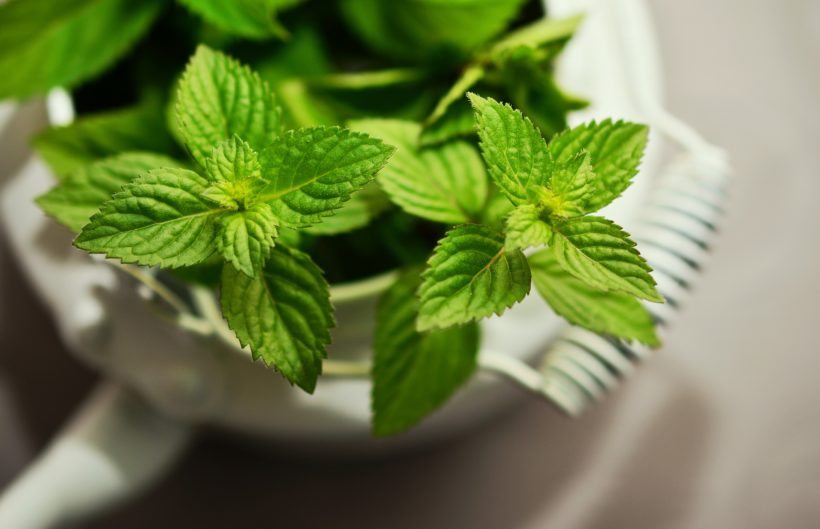It belongs to the Lamiaceae-Labiatae Family, genus Mentha, composed of 25 species of
perennial and semi-perennial aromatic herbs. They vary in size from creeping to shrubby species.
to shrubby plants. Their flavour varies according to the different varieties, ranging from
refreshing to very intense flavours.
By Horacio Mesón
Originally from Europe, mints have spread around the world to North America, Australia and also Japan,
For the Hebrews, who already knew it was a sacred drink.
Cultivated since ancient times for its medicinal properties, it has been found in an Egyptian tomb dating back to the year -1st century.
Egyptian tomb dating back to 1000 BC. In Japan, menthol (peppermint oil) has been extracted for over 2000 years.
In the Bible it is noted that the Pharisees paid a tithe on mint. It was introduced into
England by the Romans and Charlemagne, in his capitulars, imposed the cultivation of mint for its medicinal properties.
medicinal properties. In the 9th century peppermint was cultivated in convents.
Dioscorides used it as a stomach stimulant, Matthiole considered it “very suitable for the game of love”.
Everyone recognised its tonic and antispasmodic virtues, it is scientifically called
Menta spicata.
The mojito, a famous Cuban drink, includes Menta spicata in its formula. The origin of this
The origin of this cocktail goes back to 16th century Cuba where it was known as “El Draque”.
This was the name given to its creator, the English pirate and slave trader Francis Drake. Originally, the mojito was made with aguardiente to add heat, water to dilute the alcohol, lime (which, with its alcohol, lemon with its vitamin C content, helped sailors suffering from.
scurvy due to a deficiency of this vitamin as a result of spending so much time at sea without eating fruit). The mint gave it a fresh taste and the sugar made it easy to drink.
It was later improved by substituting rum for the brandy and became known as “Mojito”.
and was then called “Mojito”. This word comes from the Spanish version of the English word “Mojo”, which means mixture.
which means mixture.
Medicinal properties of Yerba Buena
- Digestive disorders: effective in cases of constipation or diarrhea, stimulates the production of digestive juices and the gall bladder. Digestive juices and the gall bladder. Effective during bouts of gastroenteritis. Difficult digestion,
bloating and gas. - Urinary disorders: diuretic effect.
- Coughs and colds: soothing.
- Pain relief: joint, muscle and headaches.
- Respiratory problems: effective against bronchitis-like conditions, inflammation of the respiratory system.
respiratory system - Against skin conditions: relieves pain related to insect and animal bites and prevents the formation of cracks.
and animal bites and prevents cracking, itchy skin and eczema. - Contains invigorating effects.
- Peppermint can be consumed in the form of industrial or home-made preparations, such as capsules, lotions, menthol-based creams, tinctures or essential oils.
- For external use apply to skin lesions, but avoid applications too close to the respiratory tract, due to risk of spasm in people with severe lung problems.
Contra indications
Peppermint should not be administered to children under 5 years of age, pregnant or breastfeeding women.
pregnant or breastfeeding women. It should be avoided in people with gall bladder disease, as well as patients who have suffered from severe liver problems. The same applies to persons prone to hypertension.
Undesirable effects
High doses may cause intestinal discomfort and headaches,
risks of hypertension have also been reported.
Drug interactions
Known dangers result from limiting the effects of certain heart medicines (heart channel blockers). (calcium channel blockers). It also blocks the elimination of a range of drugs.
Warning
Although the administration of infusions does not a priori represent any danger (except in children under 4 years of age), the use of essential oils should be done with extra caution according to the doctor’s recommendations. When used on the skin, peppermint essential oil should be diluted in another vegetable oil to avoid the risk of “burns”.
Research on peppermint
Peppermint is one of the most widely used and studied medicinal plants. Although research has focused on its action in relieving intestinal disorders and the efficacy of its diuretic effects. Scientists are also trying to understand the exact cause of its interaction with most drugs, preventing it from preventing their elimination.
If I close my eyes and let myself be carried away by its aroma, I am taken back to a time of verandas, shorts and earth-coloured knees. And a request to her who was always there, my grandmother. I have a tummy ache “Lela”.
I would say to her and she would answer: bring me some leaves of “yerba buena” baby, I’ll make you a little tea and that’s it…
horaciomeson@yahoo.com.ar
We refer to Dr. Hugo Golberg for the essential content of this article,










